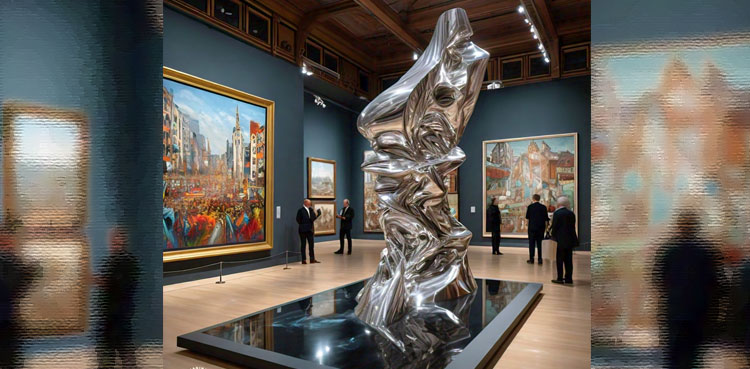More than a million art pieces and paintings sit at the Geneva Freeport warehouse complex. Together, their combined net worth is $100 billion. Almost all of them are owned by millionaires and billionaires from all over the world. It is said that none of these people have seen these paintings in person. They‘re just kind of parked in the super-secret Swiss arthouse, with no idea when they’ll be collected by their respective owners.
The Art business is arguably one of the three most unregulated industries in the world we live in, with the two others being drugs and prostitution.
In 2023, according to Statista, the USA art market had a net worth of $27.2 billion. The second spot was China with $12.2 billion followed by the UK with $10.9 billion.
One of the main reasons behind the elite going crazy over painting is the pace at which their value increases. The level of value appreciation of a typical art piece is astronomical and surpasses the levels of gold and real estate. We’ll discuss more reasons below.
The most common example would be the painting Salvador Mundi by Leonardo Da Vinci. The painting was sold for just $45 in 1958 by Sothebey’s. In 2017, it was sold at $450 million. Somewhere in history, it was revealed that this painting was once owned by the wife of King Charles the First. Its worth skyrocketed overnight.
Certain factors play in the value appreciation part. This includes the value of the artist. The auction house which had sold it. The exhibitions in which the painting has been on display so far. Most importantly: its previous owners and a bunch of controversies if there are any about the painting.
Centuries-old paintings that were owned by kings and queens bag the most in the art market. They are passed from one maven to another. From one elite to another, at a price much higher than its earlier sale.
The value of a painting is also determined by the level of the artist. Pablo Picasso’a last work. YouTube sensation Patrick Bet-David speaks of a guy who hired a local artist to create a painting with a style similar to that of Picasso’s. That guy took the painting to Picasso for review. Picasso told him it was ok but not bad. He then requested a photo with the legendary pointer to which he humbly agreed. After Picasso’s demise, the very guy falsely claimed that artwork was the last work of Picasso himself. The painting was sold for a fortune.
However, the art world of today functions from a very different level
The elites today purchase fine paintings not for the legacy but for other controversial benefits. Auctions and art galleries deliberately increase painting values as they offer loads of tax and financial benefits to the elites.
As a result, they have become a field for the rich to keep their money safe from tax agencies. This money could be black or white but could promise a high level of safety.
Let’s say I have $1 million in my bank account. If the government finds out that I got this amount of money, they will charge me taxes.
To escape this, I’ll simply purchase an art piece worth $1 million that will hang on my dining room wall as a decorative piece. I’ll get additional benefits as the painting will increase its value faster than the house I live in.
In 3 years, I could simply sell this painting at four times its value to another buyer. The money I’ll gain from selling that painting can easily be invested in another art piece. Do you see how this goes?
This way, I’ll be exempted from taxes. I can even ship my painting to a country with relaxed tax laws with minimum or no extra duty. There are a dozen other ways the money could be manipulated.
The rich use similar tactics and escape hefty tax brackets from the government. There’s no wonder the global art market has amounted to $ 1.7 trillion. Around the world, billions worth of black money is turned into white with the purchasing of fine paintings.
Sometimes the elite sell, buy, and then donate high-valued paintings to museums or charities. This gives them massive tax benefits. The donated art isn’t donated. They can reclaim that artwork whenever they like from the institute. These settings are already made when the painting is about to be donated in the first place.
Google it and one is likely to find a plethora of frauds, crimes, and tax evasion attempts. Most of these are committed by billionaires, millionaires, and oligarchs in the West.
The infamous practices are not limited to paintings alone. Luxury watches, jewelry, sculptures, collectibles to even horses are a part of this same esoteric business.
As the world progresses, we enter the era of NFTs and digital assets which have gained the attraction of the elites. At the same time, this interesting world offers opportunities for the middle-class population to invest in it too. Digital platforms like Masterworks offer people to jointly own a fine art piece and increase their investment through safe and legal means.
The future of art is even more promising. With the advent of digital assets, the value of tangible assets will drastically increase in the coming days, prompting art enthusiasts and especially the rich to part their money in an ever-increasing valued asset.




